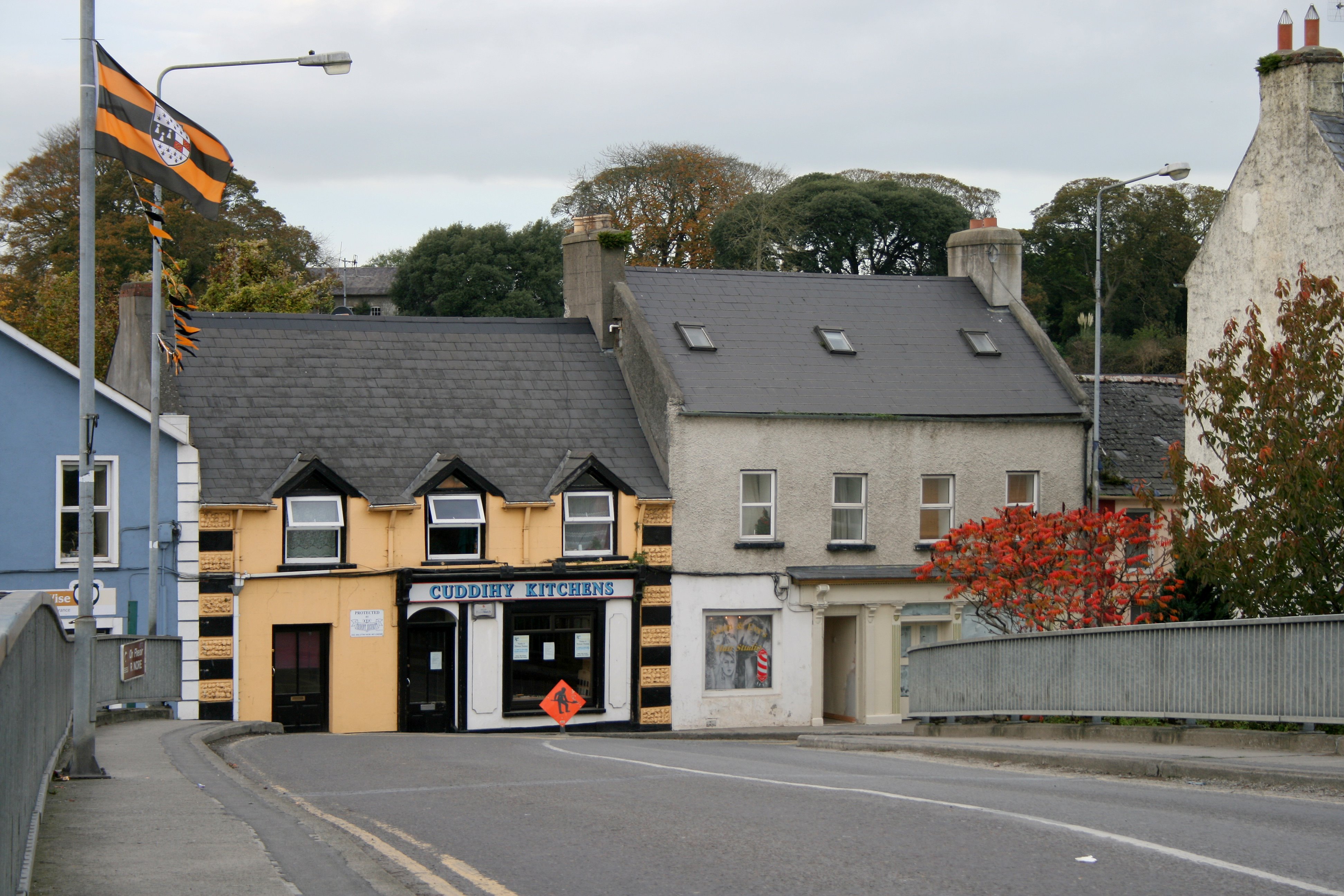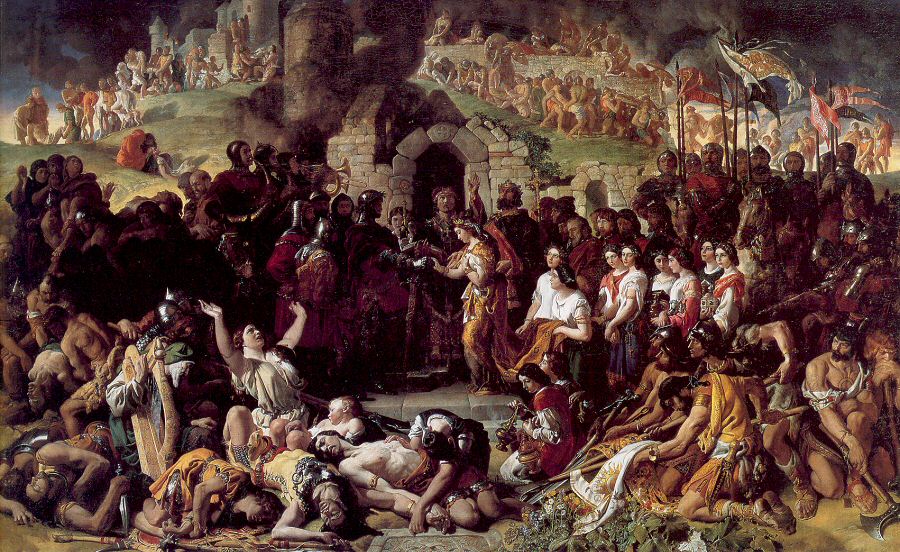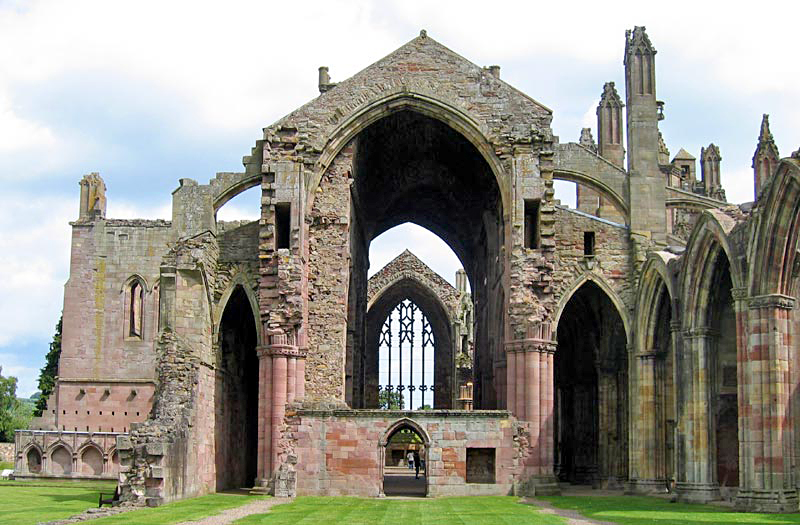|
Jerpoint
Jerpoint Abbey () is a ruined Cistercian abbey, founded in the second half of the 12th century in County Kilkenny, Ireland. It is located 2.5 km south west of Thomastown on the R448 regional road. There is a visitor centre with an exhibition. It has been declared a national monument and has been in the care of the Office of Public Works since 1880. It was constructed in 1180, by Donchadh Ó Donnchadha Mac Giolla Phátraic, the King of Osraige. It was dedicated to the Blessed Virgin. Jerpoint is notable for its stone carvings, including one at the tomb of Felix Ua Duib Sláin, Bishop of the Diocese of Ossory. The abbey flourished until the Dissolution of the Monasteries by the English king Henry VIII. Jerpoint Abbey gives its name to the civil parish of Jerpoint Abbey or Abbey-Jerpoint in the barony of Knocktopher. It lies near the anciently corporate town of Newtown Jerpoint. History In 1180, by Donogh O'Donoghoe Mac Gilla Patraic, the King of Kingdom of Ossory, mov ... [...More Info...] [...Related Items...] OR: [Wikipedia] [Google] [Baidu] |
Newtown Jerpoint
The medieval lost town of Newtown Jerpoint is just west of the Cistercian Jerpoint Abbey, near Thomastown, County Kilkenny, Ireland. It is located 3.2 km south west from Thomastown just off the R448 regional road. In the grounds of the privately owned Jerpoint Park. St. Nicholas’s Church and graveyard are in the town, where the earthly remains of St. Nicholas of Myra are said to be buried. Belmore House stands at the top of the town. History * The lost town of Newtown Jerpoint. It was founded by either Earl Marshall or Griffin Fitzwilliam in 12th century where the main crossing of the River Nore was formed by a toll bridge, giving Jerpoint its name as it means 'Nore bridge'. * It was a vibrant town, with approx 27 dwelling houses, a court house, woollen mill, a tannery, a brewery and reputed to have had 14 taverns. * Newtown Jerpoint lasted at least into the 17th century, but eventually declined, perhaps from the loss of its bridge and the re-routing of the road. It ... [...More Info...] [...Related Items...] OR: [Wikipedia] [Google] [Baidu] |
County Kilkenny
County Kilkenny ( gle, Contae Chill Chainnigh) is a county in Ireland. It is in the province of Leinster and is part of the South-East Region. It is named after the city of Kilkenny. Kilkenny County Council is the local authority for the county. As of the 2022 census the population of the county was just over 100,000. The county was based on the historic Gaelic kingdom of Ossory (''Osraighe''), which was coterminous with the Diocese of Ossory. Geography and subdivisions Kilkenny is the 16th-largest of Ireland's 32 counties by area, and the 21st largest in terms of population. It is the third-largest of Leinster's 12 counties in size, the seventh-largest in terms of population, and has a population density of 48 people per km2. Kilkenny borders five counties - Tipperary to the west, Waterford to the south, Carlow and Wexford to the east, and Laois to the north. Kilkenny city is the county's seat of local government and largest settlement, and is situated on the Ri ... [...More Info...] [...Related Items...] OR: [Wikipedia] [Google] [Baidu] |
Kingdom Of Ossory
Osraige (Old Irish) or Osraighe (Classical Irish), Osraí (Modern Irish), anglicized as Ossory, was a medieval Irish kingdom comprising what is now County Kilkenny and western County Laois, corresponding to the Diocese of Ossory. The home of the Osraige people, it existed from around the first century until the Norman invasion of Ireland in the 12th century. It was ruled by the Dál Birn dynasty, whose medieval descendants assumed the surname Mac Giolla Phádraig. According to tradition, Osraige was founded by Óengus Osrithe in the 1st century and was originally within the province of Leinster. In the 5th century, the Corcu Loígde of Munster displaced the Dál Birn and brought Osraige under Munster's direct control. The Dál Birn returned to power in the 7th century, though Osraige remained nominally part of Munster until 859, when it achieved formal independence under the powerful king Cerball mac Dúnlainge. Osraige's rulers remained major players in Irish politics f ... [...More Info...] [...Related Items...] OR: [Wikipedia] [Google] [Baidu] |
Thomastown
Thomastown (), historically known as Grennan, is a town in County Kilkenny in the province of Leinster in the south-east of Ireland. It is a market town along a stretch of the River Nore which is known for its salmon and trout, with a number of historical landmarks in the vicinity. Visitor attractions include Jerpoint Abbey, Kilfane Glen gardens, and Mount Juliet Golf Course. Location The town is situated at a bridging point on the River Nore from the city of Kilkenny. As of Census 2016, Thomastown had a population of 2,445, making the town the third most populous in the county. The R448 Naas–Waterford road passes through Thomastown, the town is serviced by buses and has a railway station. The Callan–Thomastown local electoral area contains the electoral divisions of Aghaviller, Ballyhale, Ballyvool, Bennettsbridge, Boolyglass, Bramblestown, Brownsford, Burnchurch, Callan Rural, Callan Urban, Castlebanny, Coolaghmore, Coolhill, Danesfort, Dunbell, Dunnamaggan, Dys ... [...More Info...] [...Related Items...] OR: [Wikipedia] [Google] [Baidu] |
Kingdom Of Osraige
Osraige (Old Irish) or Osraighe (Classical Irish), Osraí (Modern Irish), anglicized as Ossory, was a medieval Irish kingdom comprising what is now County Kilkenny and western County Laois, corresponding to the Diocese of Ossory. The home of the Osraige people, it existed from around the first century until the Norman invasion of Ireland in the 12th century. It was ruled by the Dál Birn dynasty, whose medieval descendants assumed the surname Mac Giolla Phádraig. According to tradition, Osraige was founded by Óengus Osrithe in the 1st century and was originally within the province of Leinster. In the 5th century, the Corcu Loígde of Munster displaced the Dál Birn and brought Osraige under Munster's direct control. The Dál Birn returned to power in the 7th century, though Osraige remained nominally part of Munster until 859, when it achieved formal independence under the powerful king Cerball mac Dúnlainge. Osraige's rulers remained major players in Irish politics for t ... [...More Info...] [...Related Items...] OR: [Wikipedia] [Google] [Baidu] |
Felix Ua Duib Sláin
Felix Ua Duib Sláin (; – 24 January 1202), often anglicised as Felix O'Dullany (''O'Dulaney'', ''O'Dullaney'', ''O'Dulany'' etc.) was a medieval Irish bishop. Biography Felix had a Latin first name meaning "fortunate"; his surname literally means "grandson/descendant of Dubh Shláine," an Irish name meaning "black aired?one of the Slaney", a family formerly powerful in the Upper Woods area of modern County Laois. Felix is recorded as a member of the Order of Cistercians, taking on the white habit at either Baltinglass Abbey or Mellifont Abbey. He is credited with founding Jerpoint Abbey. However, this is not certain; John R. Sommerfeldt, a Cistercian historian, claimed that Felix may actually have been a Benedictine. Felix became Bishop of Ossory, located in southeast Ireland, between 1178 and 1180. He is known for his association with St John's Priory, Kilkenny; around 1200 he granted the tithes of Kilkenny Castle to Brother Osbert, the Prior of Saint John's H ... [...More Info...] [...Related Items...] OR: [Wikipedia] [Google] [Baidu] |
Saint Nicholas
Saint Nicholas of Myra, ; la, Sanctus Nicolaus (traditionally 15 March 270 – 6 December 343), also known as Nicholas of Bari, was an early Christian bishop of Greek descent from the maritime city of Myra in Asia Minor (; modern-day Demre, Turkey) during the time of the Roman Empire. Because of the many miracles attributed to his intercession, he is also known as Nicholas the Wonderworker. Saint Nicholas is the patron saint of sailors, merchants, archers, repentant thieves, children, brewers, pawnbrokers, unmarried people, and students in various cities and countries around Europe. His reputation evolved among the pious, as was common for early Christian saints, and his legendary habit of secret gift-giving gave rise to the traditional model of Santa Claus ("Saint Nick") through Sinterklaas. Little is known about the historical Saint Nicholas. The earliest accounts of his life were written centuries after his death and probably contain legendary elaborations. He is ... [...More Info...] [...Related Items...] OR: [Wikipedia] [Google] [Baidu] |
Cistercians
The Cistercians, () officially the Order of Cistercians ( la, (Sacer) Ordo Cisterciensis, abbreviated as OCist or SOCist), are a Catholic religious order of monks and nuns that branched off from the Benedictines and follow the Rule of Saint Benedict, as well as the contributions of the highly-influential Saint Bernard of Clairvaux, known as the Latin Rule. They are also known as Bernardines, after Saint Bernard himself, or as White Monks, in reference to the colour of the "cuculla" or cowl (choir robe) worn by the Cistercians over their habits, as opposed to the black cowl worn by Benedictines. The term ''Cistercian'' derives from ''Cistercium,'' the Latin name for the locale of Cîteaux, near Dijon in eastern France. It was here that a group of Benedictine monks from the monastery of Molesme founded Cîteaux Abbey in 1098, with the goal of following more closely the Rule of Saint Benedict. The best known of them were Robert of Molesme, Alberic of Cîteaux and the En ... [...More Info...] [...Related Items...] OR: [Wikipedia] [Google] [Baidu] |
Bishop Of Cork
The Bishop of Cork was a separate episcopal title which took its name after the city of Cork in Ireland. The title is now united with other bishoprics. In the Church of Ireland it is held by the Bishop of Cork, Cloyne and Ross, and in the Roman Catholic Church it is held by the Bishop of Cork and Ross. Pre-Reformation bishops The diocese of Cork was one of the twenty-four dioceses established at the Synod of Rathbreasail on an ancient bishopric founded by Saint Finbarr in the sixth-century. On 30 July 1326, Pope John XXII, on the petition of King Edward II of England, issued a papal bull for the union of the bishoprics of Cork and Cloyne, the union to take effect on the death of either bishop. The union should have taken effect on the death of Philip of Slane in 1327, however, bishops were still appointed to each separate bishopric. The union eventually took place with Jordan Purcell appointed bishop of the united see of Cork and Cloyne in 1429. Post-Reformation bishops Fo ... [...More Info...] [...Related Items...] OR: [Wikipedia] [Google] [Baidu] |
Cistercian
The Cistercians, () officially the Order of Cistercians ( la, (Sacer) Ordo Cisterciensis, abbreviated as OCist or SOCist), are a Catholic religious order of monks and nuns that branched off from the Benedictines and follow the Rule of Saint Benedict, as well as the contributions of the highly-influential Saint Bernard of Clairvaux, known as the Latin Rule. They are also known as Bernardines, after Saint Bernard himself, or as White Monks, in reference to the colour of the "cuculla" or cowl (choir robe) worn by the Cistercians over their habits, as opposed to the black cowl worn by Benedictines. The term ''Cistercian'' derives from ''Cistercium,'' the Latin name for the locale of Cîteaux, near Dijon in eastern France. It was here that a group of Benedictine monks from the monastery of Molesme founded Cîteaux Abbey in 1098, with the goal of following more closely the Rule of Saint Benedict. The best known of them were Robert of Molesme, Alberic of Cîteaux and the Engl ... [...More Info...] [...Related Items...] OR: [Wikipedia] [Google] [Baidu] |






